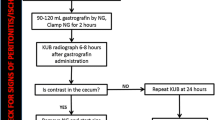Summary
Jejunal diverticula are rare and usually asymptomatic; they occur twice as frequently in men. They are discovered incidentally during small-bowel enteroclysis, CT scan or laparotomy. Complications include diverticulitis, perforation, hemorrhage and enterolith formation. Intestinal obstruction due to enterolithiasis is uncommon. We present the association of enterolithiasis and jejunal diverticulosis causing obstruction of the small intestine in a 74-year-old female who was admitted for abdominal cramps, nausea and vomiting. On physical examination, there was discomfort on palpation of the upper abdomen. Laboratory tests revealed mild elevation of leucocytes and C-reactive protein. CT scan demonstrated dilatated loops of proximal jejunum with thickening of the wall, suggesting ingestion of a foreign body. Clinical and radiological findings did not indicate conservative therapy; our patient underwent minilaparotomy, and pronounced jejunal diverticulosis was identified. An enterotomy was performed and a cylindrical enterolith, 10 cm long and 3 cm in diameter, was removed. The operative and postoperative course was uneventful. Enterolithiasis must be considered as a potential source of intestinal obstruction. The differential diagnosis should take gallstone ileus and ingestion of a foreign body into consideration. Initial therapy is nonoperative; if this management fails, surgery is indicated.
Zusammenfassung
Jejunaldivertikula sind gewöhnlich asymptomatisch und ihr Auftreten ist selten. Sie werden zufällig im Rahmen eines Dünndarm-Doppelkontraströntgens, Computertomographie oder Laparotomie entdeckt. Das Auftreten ist bei Männern doppelt so häufig. Komplikationen, die auftreten können, sind Divertikulitis, Perforation, Blutung und Enterolithbildung. Eine intestinale Obstruktion bei Enterolithiasis ist selten. Wir berichten über eine 74-jährige Patientin, die wegen Bauchkrämpfen, Übelkeit und Erbrechen stationär aufgenommen wurde. Bei der klinischen Untersuchung imponierte ein Druckschmerz im Oberbauch. Die Laboruntersuchungen zeigten eine geringe Erhöhung der Leukozyten und des C-reaktiven Proteins. In der Computertomographie fielen weite und wandverdickte Dünndarmschlingen des proximalen Jejunums auf. Weiters wurde der Verdacht auf eine Fremdkörperingestion gestellt. Aufgrund der klinischen und radiologischen Befunde war eine konservative Therapie nicht zielführend. Es wurde eine Minilaparotomie durchgeführt und eine ausgeprägte Jejunaldivertikulose festgestellt. Durch eine Enterotomie konnte ein 10 cm langer und 3 cm im Durchmesser großer Enterolith entfernt werden. Der operative und postoperative Verlauf war komplikationslos. Die Enterolithiasis muss als mögliche Ursache eines Dünndarmileus in Betracht gezogen werden. Differentialdiagnostisch muss an eine Fremdkörperingestion und Gallensteinileus gedacht werden. Die primäre Therapie ist konservativ, führt diese nicht zum Erfolg, muss der Stein chirurgisch entfernt werden.
Similar content being viewed by others
Author information
Authors and Affiliations
Corresponding author
Rights and permissions
About this article
Cite this article
Kornprat, P., Langner, C. & Mischinger, H.J. Enterolithiasis in jejunal diverticulosis, a rare cause of obstruction of the small intestine: a case report. Wien Klin Wochenschr 117, 297–299 (2005). https://doi.org/10.1007/s00508-004-0277-8
Received:
Accepted:
Issue Date:
DOI: https://doi.org/10.1007/s00508-004-0277-8




